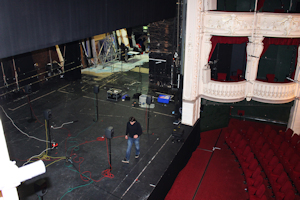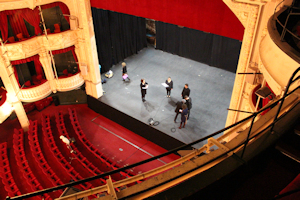
York Theatre Royal is a regional producing theatre in the centre of York based on a site that has hosted a working theatre since 1744. It is built on the location of the 12th-century St Leonard's Hospital, parts of which are still evident in the modern building, together with the Georgian interior and a Victorian façade, in combination with more recent architectural interventions. Under the stage is a well that dates from the Roman period of York's history. In 2015 the theatre was subject to a major refurbishment, providing a unique opportunity to apply virtual acoustics research in a culturally and historically significant space as part of this process. To date this has involved the capture of impulse response and 360-degree image data, for various on-stage performer (sound source) and audience seating positions, and although most of this work took place outside of the normal rehearsal and production cycle, and hence in an empty theatre, this did also include data capture during a production with a full audience in place. The acoustic measurement and data-gathering process started in late 2014, and was completed by early 2015, before the refurbishment work started (Figures 25–26).

Creative applications for pre-refurbishment data have already been explored: Virtual Reality (VR) headset technology has allowed the combination of 360-degree images with immersive, binaural, head-tracked auralisation. Head-tracking is important to develop an immersive and plausible virtual reality experience so that the audio scene is updated as the subject's head moves, such that sound sources maintain their positions relative to each other and the orientation of the subject's head (compare, for instance, with standard stereo headphone listening where this does not take place). Hence it is now possible for a subject to experience a recorded performance from different seats in the house, and experience the sense of a theatre auditorium that no longer exists in this form. Virtual reality and auralisation combined enable new levels of creativity and opportunity to experience heritage and explore questions raised. One challenge relates to moving auralisation beyond the auditory sense to encompass rich visual assets via an immersive medium such as a VR-headset, and how we relate this to a sense of embodiment in the rendered scene. When viewing the stage of York Theatre Royal from a seat in the stalls, there is a sense of hovering somewhere above the seat itself. The perception matches our experience, yet when we look down we do not see our own body and nor can we interact with this scene with our own hands. Furthermore, theatre is usually a shared experience, yet such rendering places our virtual self in an empty theatre space. The need for high-quality acoustic measurement and image capture demands a controlled environment, yet produces a result very different from what a typical theatre-goer might expect.

Aside from considering questions such as these, our aim with this project is two-fold: to use acoustic heritage, auralisation and sound design to tell the story of the theatre space, and reveal the rich, multiple layers of its history; and to encourage new means of engaging with and accessing theatre performance - to develop new audiences, and deliver new experiences for those who already exist. York Theatre Royal re-opened in April 2015 and this collaboration continues to explore how such digital assets might be deployed effectively to these ends. Further work on this project will involve post-refurbishment acoustic measurements and 360-degree image capture for the new auditorium space, and the development of an interactive, online, virtual York Theatre Royal auditorium explorer, to compare audio/visual experiences of a performance from different seats within the main house.
Internet Archaeology is an open access journal based in the Department of Archaeology, University of York. Except where otherwise noted, content from this work may be used under the terms of the Creative Commons Attribution 3.0 (CC BY) Unported licence, which permits unrestricted use, distribution, and reproduction in any medium, provided that attribution to the author(s), the title of the work, the Internet Archaeology journal and the relevant URL/DOI are given.
Terms and Conditions | Legal Statements | Privacy Policy | Cookies Policy | Citing Internet Archaeology
Internet Archaeology content is preserved for the long term with the Archaeology Data Service. Help sustain and support open access publication by donating to our Open Access Archaeology Fund.